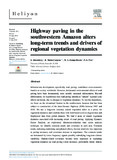Mostrar el registro sencillo del ítem
Highway paving in the southwestern Amazon alters long-term trends and drivers of regional vegetation dynamics
| dc.creator | Klarenberg, Geraldine | es_ES |
| dc.creator | Muñoz Carpena, Rafael | es_ES |
| dc.creator | Campo-Bescós, Miguel | es_ES |
| dc.creator | Perz, Steve G. | es_ES |
| dc.date.accessioned | 2019-02-25T14:51:04Z | |
| dc.date.available | 2019-02-25T14:51:04Z | |
| dc.date.issued | 2018 | |
| dc.identifier.issn | 2405-8440 | |
| dc.identifier.uri | https://hdl.handle.net/2454/32428 | |
| dc.description.abstract | Infrastructure development, specifically road paving, contributes socio-economic benefits to society worldwide. However, detrimental environmental effects of road paving have been documented, most notably increased deforestation. Beyond deforestation, we hypothesize that road paving introduces “unseen” regional scale effects on forests, due to changes to vegetation dynamics. To test this hypothesis, we focus on the tri-national frontier in the southwestern Amazon that has been subject to construction of the Inter-Oceanic Highway (IOH) between 1987 and 2010. We use a long-term remotely sensed vegetation index as a proxy for vegetation dynamics and combine these with field-based socio-ecological data and biophysical data from global datasets. We find 4 areas of shared vegetation dynamics associated with increasing extent of road paving. Applying Dynamic Factor Analysis, an exploratory dimension-reduction time series analysis technique, we identify common trends and covariates in each area. Common trends, indicating underlying unexplained effects, become relatively less important as paving increases, and covariates increase in importance. The common trends are dominated by lower frequency signals possibly embodying long-term climate variability. Human-related covariates become more important in explaining vegetation dynamics as road paving extent increases, particularly family density and travel time to market. Natural covariates such as minimum temperature and soil moisture become less important. The change in vegetation dynamics identified in this study indicates a possible change in ecosystem services along the disturbance gradient. While this study does not include all potential factors controlling dynamics and disturbance of vegetation in the region, it offers important insights for management and mitigation of effects of road paving projects. Infrastructure planning initiatives should make provisions for more detailed vegetation monitoring after road completion, with a broader focus than just deforestation. The study highlights the need to mitigate population-driven pressures on vegetation like family density and access to new markets. | en |
| dc.description.sponsorship | This work was supported by funding from NSF CNH Award number 1114924, USA. | en |
| dc.format.extent | 40 p. | |
| dc.format.mimetype | application/pdf | en |
| dc.format.mimetype | application/zip | en |
| dc.language.iso | eng | en |
| dc.publisher | Elsevier | en |
| dc.relation.ispartof | Heliyon, 4 (2018) e00721 | en |
| dc.rights | © 2018 Published by Elsevier Ltd. This is an open access article under the CC BY-NC-ND license. | en |
| dc.rights.uri | http://creativecommons.org/licenses/by-nc-nd/4.0/ | |
| dc.subject | Environmental science | en |
| dc.subject | Geography | en |
| dc.title | Highway paving in the southwestern Amazon alters long-term trends and drivers of regional vegetation dynamics | en |
| dc.type | Artículo / Artikulua | es |
| dc.type | info:eu-repo/semantics/article | en |
| dc.contributor.department | Ingeniería | es_ES |
| dc.contributor.department | Ingeniaritza | eu |
| dc.rights.accessRights | Acceso abierto / Sarbide irekia | es |
| dc.rights.accessRights | info:eu-repo/semantics/openAccess | en |
| dc.identifier.doi | 10.1016/j.heliyon.2018.e00721 | |
| dc.relation.publisherversion | https://doi.org/10.1016/j.heliyon.2018.e00721 | |
| dc.type.version | Versión publicada / Argitaratu den bertsioa | es |
| dc.type.version | info:eu-repo/semantics/publishedVersion | en |



